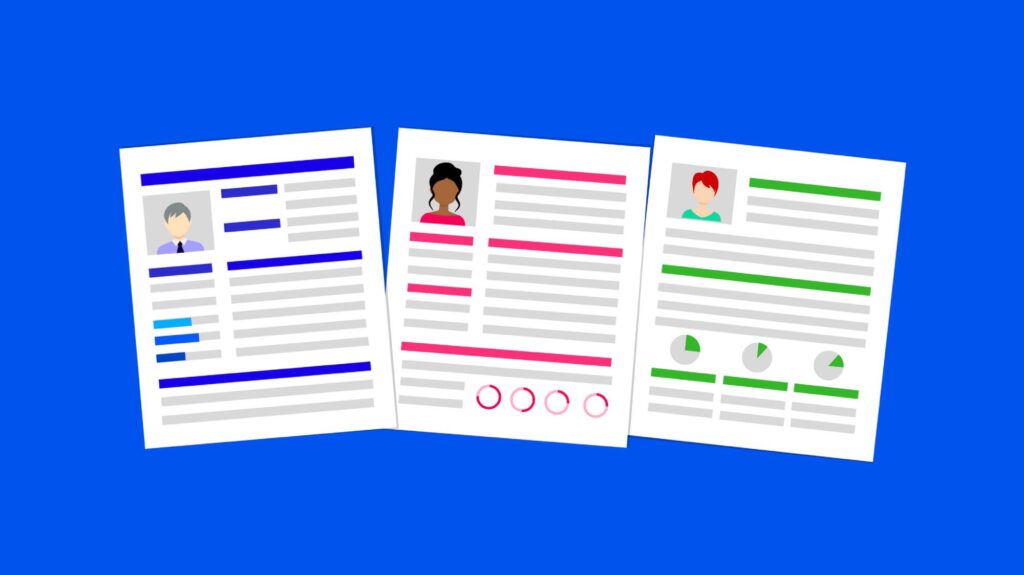
How to Write an MBA Resume
Read Time Estimate: 9 minutes
August 29th, 2024
Are you ready to head off to your university of choice and obtain your MBA? It’s not as easy as you may think. For the fall of 2023, the average acceptance rate was 49.7% among 124 universities that provided data, and your chances of getting accepted decrease as you apply to tougher programs.
However, that doesn’t mean you should give up hope. It does mean that you need to hit the ball out of the park with your MBA resume.
It’s not as simple as just throwing some data on a Word document, so join us as we explore crafting MBA resumes.
What’s the Difference Between an MBA Resume and a Traditional Job Resume?
An MBA resume differs significantly from a traditional job resume. While both highlight your skills and experiences, an MBA resume is tailored specifically for business school applications. It focuses on the following and more:
- Academic achievements
- Leadership roles
- Professional growth
In contrast, a traditional job resume emphasizes work experience and accomplishments related to specific positions. For MBA degree applicants, showcasing your potential as a future leader is key.
How Important Is an MBA Resume?
An MBA resume is crucial for anyone looking to elevate their career. It’s your first impression and can set the tone for future opportunities. Admissions committees sift through countless applications, so yours needs to stand out.
Your resume for MBA programs showcases your work experience and your potential as a leader and innovator. A well-crafted MBA resume highlights relevant skills and achievements that demonstrate why you’re an ideal candidate.
It also helps with networking; prospective employers often request resumes during informational interviews or recruitment events. Your MBA resume is a tool that can open doors to conversations about exciting opportunities ahead.
Is it Okay to Use AI to Help Write an MBA Resume?
AI is a hot topic right now, and some people may recommend having programs like ChatGPT write your resume for you. There’s no denying that using AI to help craft your MBA resume can be a valuable tool.
It offers suggestions for wording and structure that can elevate your presentation. Many candidates find it helpful in brainstorming or overcoming writer’s block.
However, it’s essential to remember that personal touch matters. An AI-generated resume may lack the unique insights into your experiences and achievements that only you can provide.
Make sure any content generated accurately reflects your voice and brand. Use AI as a supplementary resource rather than a crutch, and allow your personality to shine through in every line of text. Balancing technology with authenticity is key to standing out.
What Should You Include in an MBA Resume?
Now we’re really digging in. We know that an MBA resume is important and that it’s not the same as a job resume. However, knowing what to include in your MBA resume is also important.
Some of our recommendations include the following:
- The Basics
- Job Experience
- Education
- Skills and Rewards
- Volunteer Experience
Let’s explore each of these areas more in-depth.
The Basics:
When crafting your MBA resume, start with the basics. Clearly include your name and contact information at the top. Make it easy for admissions committees to reach you.
Next, choose a professional format that highlights your accomplishments without overwhelming details. A clean layout helps with readability and allows key points to shine through.
Keep the length to one page if possible. Admissions officers often skim resumes due to time constraints. You’ll capture their attention quickly by maintaining brevity while showcasing what makes you stand out as an MBA candidate.
If you have extensive experience or accomplishments, you can go to two pages. However, do so with caution.
Job Experience:
Highlighting your job experience is crucial for an MBA resume. The job experience section showcases your professional journey and the skills you’ve gained. Include relevant positions that demonstrate leadership, teamwork, and problem-solving abilities.
Use bullet points to describe your responsibilities clearly and concisely. Focus on achievements rather than just tasks. This gives a more vivid picture of your contributions. For example, mention if you led a project that increased sales or streamlined processes.
Remember to tailor this information to align with the MBA programs you’re interested in. Emphasizing experiences related to business management will make your resume stand out even more!
Education:
When detailing your education on an MBA resume, start with your most recent degree. Clearly include the following information:
- Institutions name
- Degree type
- Graduation date
If you graduated with honors or earned a notable GPA, be sure to include that. Also, mention any relevant coursework or certifications you have completed. Highlighting specialized courses can demonstrate your commitment to advancing in particular business areas.
For candidates with advanced degrees, it’s often best to keep undergraduate details brief. Just listing your degree and major can suffice unless something exceptional is worth showcasing, like leadership roles or impactful projects during that time.
Skills and Rewards:
Focus on both hard and soft skills that are relevant to the business world. Think about what makes you unique and sets you apart. This could include the following and more:
- Leadership abilities
- Analytical prowess
- Exceptional communication skills
Don’t forget to include any awards or recognitions you’ve received. These accomplishments speak volumes about your dedication and capabilities. Whether it’s a scholarship, an employee of the month award, or accolades in competitions, showcasing these achievements adds credibility.
Volunteer Experience:
Including volunteer experience on your MBA resume can set you apart from other candidates. It showcases your commitment to community service and leadership skills. Admissions committees value applicants who demonstrate a well-rounded character.
When detailing your volunteer work, focus on roles that highlight transferable skills relevant to business settings. For instance, managing a team or organizing events shows initiative and teamwork capabilities.
Be specific about the impact of your contributions. Quantify your achievements using numbers where possible, such as the number of people you helped or the funds raised.
Structuring and Formatting Your MBA Application Resume
Structuring your MBA resume is key to making a great impression. Start with clear sections, such as:
- Contact information
- Education
- Work experience
- Skills
- Additional activities
Clear organization helps admissions committees easily navigate your accomplishments.
Formatting should be clean and professional. Use consistent fonts and sizes throughout the document. White space is crucial; it makes your resume easier to read while drawing attention to important details.
Keep it concise, and remember to aim for one page if possible. Bullet points can help highlight achievements without overwhelming the reader with text.
Tips for Crafting MBA Resumes
Ready to impress potential employers with a standout MBA resume? Let’s dive into the key components and tips to create a document that showcases your qualifications and achievements.
We’ll cover the following MBA resume tips:
- Be Concise
- Use an Easy to Read Format
- Put the Most Important Information at the Top
- Demonstrate Leadership
- Quantify Your Achievements
- Proofread, Proofread, Proofread
Be Concise:
Admissions committees sift through countless applications, making every second count. Being concise helps you stand out and prevents information overload.
Focus on using clear language and straightforward descriptions. Avoid jargon or overly complex phrases that may confuse the reader. Instead, use strong action verbs to convey your achievements succinctly.
Remember, less is often more. Limit your resume to one or two pages while showcasing relevant experiences and skills. Highlight what truly matters to maximize impact and keep the reviewer engaged.
Use an Easy to Read Format:
An easy-to-read format helps the admissions committee quickly grasp who you are and what you bring to the table. Use a clean layout with ample white space; this invites the reader’s eye to flow naturally through your accomplishments.
Choose a simple font style, like Arial or Calibri, and maintain consistent formatting throughout. Bullet points can effectively highlight key achievements without overwhelming text blocks.
Don’t forget about section headings! They act as signposts that guide readers through your story. Headings also help keep it straightforward and ensure every detail shines in its best light while keeping everything organized for maximum impact.
Put the Most Important Information at the Top:
When structuring your MBA resume, think like an admissions professional. They often skim through resumes quickly, and placing the most important information at the top captures their attention right away.
Start with your key achievements and skills that align with the program’s values. This gives them a snapshot of what you bring to the table without diving deep into every detail.
First impressions matter! By prioritizing essential details, you increase your chances of making a positive impact from the get-go.
Demonstrate Leadership:
Business schools value candidates who can inspire and guide others. Think about times you’ve taken charge of projects or initiatives.
Include specific examples of how you led a team to success. Describe the challenges faced and how your leadership made a difference. Use action verbs to help truly show what you did. Details like this add depth to your experiences.
Remember, it’s not just about titles; the impact matters. Highlight instances of motivation and collaboration within teams. Demonstrating leadership qualities will make your MBA application stand out among others vying for admission.
Quantify Your Achievements:
When crafting your MBA resume, numbers speak volumes. Quantifying your achievements helps potential schools visualize your impact. Instead of saying you led a team, mention that you supervised a project with ten team members that delivered a 20% increase in efficiency.
By adding figures, you’re not just sharing what you’ve done; you’re showcasing the value you bring. For instance, if you managed budgets or increased sales, provide those percentages directly to illustrate success.
Using this method transforms vague descriptions into compelling stories of achievement. It creates an immediate impression and sets you apart from other candidates who may overlook this crucial detail.
Proofread, Proofread, Proofread:
Does one minor spelling or grammar mistake really matter? After all, typos happen to even the best writers. However, it does matter.
In just the job search field, spelling and grammar errors on a resume will cause around 77% of hiring professionals to reject a candidate. If you get down into the details and the only difference between you and another candidate is a typo, you don’t want that one mistake to make the decision for you.
Your MBA resume is a reflection of your professional self. A single typo can undermine all your hard work and achievements. Take the time to proofread every section meticulously.
Read through your resume multiple times, and consider asking a friend or colleague to review it as well. Fresh eyes often catch errors you might have overlooked. They can also provide valuable feedback on clarity and impact.
Don’t forget that formatting matters, too! Ensure consistent font sizes, bullet points, and spacing throughout the document. A polished presentation enhances readability and shows attention to detail – an essential quality in any MBA candidate.
Should You Change Your MBA Resume for Every Business School?
Yes, you should tailor your MBA resume for each business school. Different programs have unique values and cultures that they prioritize. By customizing your resume, you can highlight experiences and skills aligning with the school’s needs.
Take time to research each school’s mission statement and core competencies. This information will help you understand what qualities they appreciate in candidates. Adjusting your resume accordingly shows commitment and genuine interest.
Additionally, showcasing specific achievements relevant to the program can set you apart from other applicants. A personalized approach makes a lasting impression on admissions committees, who are looking for candidates that fit their community.
Start Your Notre Dame de Namur University MBA Application
Starting your MBA application at Notre Dame de Namur University is an exciting step toward advancing your career. As you prepare your MBA resume, remember that it’s your chance to showcase who you are and what you’ve accomplished.
Are you ready to get started? Notre Dame de Namur University has been helping students build their desired future for over 170 years. Our diverse and inclusive learning community will challenge you to be your best personally, professionally, and publicly.
Start your path toward a more fulfilling career with the right education. Get in touch with our admissions team to get more information today by filling out the form below.
More From NDNU

Master of Arts vs. Master of Science: What’s the Difference?
November 22nd, 2024 Master of Arts vs. Master of Science: What’s the Difference? There are many benefits to earning a graduate degree. Through a master’s

Is an MBA Worth It?
January 7th, 2025 Is an MBA Worth It? Earning a Master of Business Administration (MBA) can be a gateway to success in the corporate world.

Is a Bachelor’s Degree Worth It?
November 27th, 2024 Is a Bachelor’s Degree Worth It? In today’s fast-paced world, you might wonder if a bachelor’s degree is worth it. Does the

